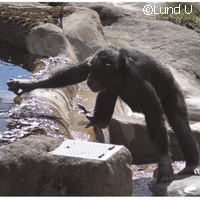Chimp shows cunning way to get target
The Furuvik Zoo in Sweden is home to Santino, the chimpanzee known for gathering stones and making concrete projectiles to throw at anyone visiting the zoo in 2009. But stone-throwing is not all that Santino does. A new study has found that the infamous chimp finds innovative ways to fool the visitors. Presented in the journal PLoS ONE, the findings suggest that chimps can represent the future behaviours and actions of others while those others are not present, effectively producing a future event instead of merely preparing for an event. The results might indicate that chimps recombine episodic memories in perceptual simulations. Researchers from Lund University in Sweden investigated the ability a chimp has to carry out complex planning. They observed that chimps, which experts believe are the closest relatives from the animal kingdom to humans, have the capacity to fool others cunningly and skilfully. Santino's behaviour piqued the curiosity of researchers, because he planned the deception when the humans were out of sight. In a nutshell, the chimp followed through on his plan without having immediate perceptual feedback of his objective, which in this case, were the people visiting the zoo. Santino became popular worldwide in 2009 when visitors to the zoo were the targets of his stones and concrete projectiles. Researchers thought then that his behaviour was an example of spontaneous planning for a future event. So his psychological state was clearly different from that of his subsequent aggressive displays. Most researchers have long thought that such cognitive abilities belonged only to humans. For the purposes of this study, the researchers collected more detailed data on Santino's projectile-throwing behaviour over the course of the 2010 zoo season. They found that Santino continued and extended his previous behaviour of caching projectiles to be used for future throwing displays of aggression. The chimp also showed an innovative use of concealments: those made from hay and those made naturally (e.g. rock). To test Santino, the team placed the people participating in the study in the visitors' area. The chimp could throw his missiles before the people had a chance to get away. Santino created his hay concealments when the visitors were away. He launched his missiles when they returned. During their observation of the chimp, the researchers discovered that Santino preferred to conceal his missiles. However, he combined two strategies consistently: he hid projectiles and he inhibited the displays of dominance that otherwise preceded his throws. 'When planning for potential future behaviours of others, we suggest that this could in principle also be solved by detached perceptual construct of behaviours priorly experienced under different circumstances,' the authors of the study write. 'Then there is no need for theory like reasoning about others' mental states; the behaviour could be "read" from the perceptual simulations (it is not necessary to represent other's mental states even for creating the constructs; a learned behavioural catalogue would suffice). What underlies the perceptual simulations of potential futures, what makes them [...] form, is a highly interesting question beyond the scope of speculations of this study.' The researchers say further work should be carried out to determine whether chimps, and other great apes, are in general capable of planning for future deception, and whether they can form representations of future behaviours of others who are out of sight.For more information, please visit: Lund University:http://www.lunduniversity.lu.se/PLoS ONE:http://www.plosone.org/home.action
Countries
Sweden



